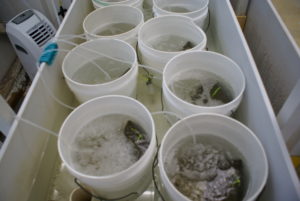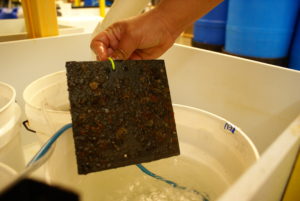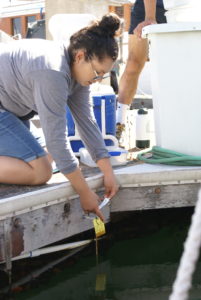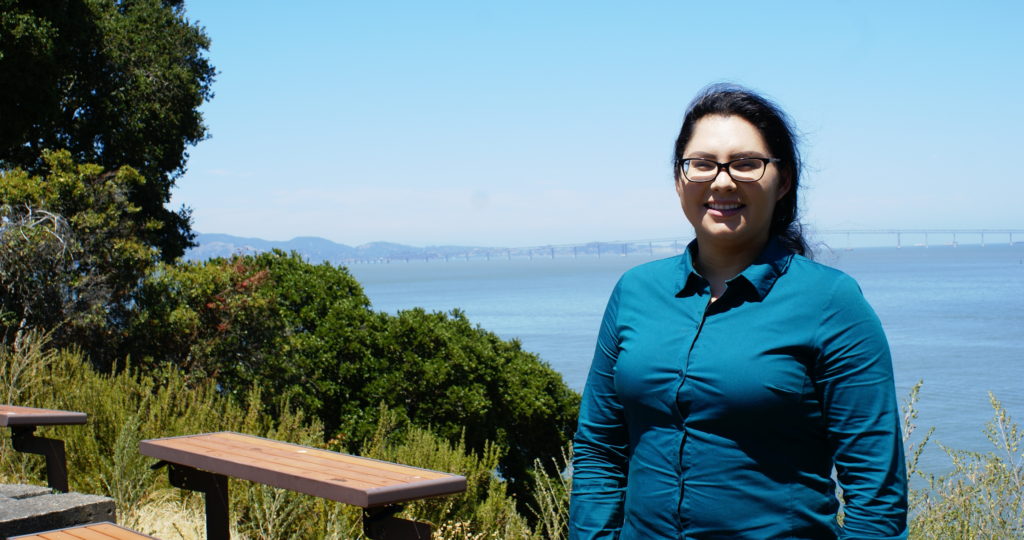by Alison Haigh
Science comes with some wacky challenges. In the world of marine invasions, that might include sunburns from afternoons tying equipment to docks or worrying about how much seafood powder to feed a plate of invertebrates. But when someone dons a lab coat, they don’t shed their homelife, background, and personal responsibilities. At SERC-West, intern Jessenia Suarez got to know some of those unique challenges while working on her research project. But one of her biggest challenges was outside the lab.
Suarez is a senior marine biology major at San Francisco State University who found her passion for biology in her second year at community college. In summer 2019, she studied how a group of underwater creatures known as the fouling community responds to changes in water temperature. She found the work exciting and refreshing—but she admits that her biggest challenges were balancing the internship with a two-hour commute and finding childcare for her two-year-old daughter, Leia.
“I would spend about an hour and a half with her when I got home, and then it would be time to sleep,” she said. “Not only that, but I was still working my other job [as a CVS pharmacy technician]—very few hours, but it’s still time away from her. It was hard for me, and it was hard for her too.”
Besides caring for her daughter and working a second job, she also had to balance classes. Yet despite a heavier workload than the average intern, Suarez loved the internship experience, and she’s passionate about pursuing research after her degree.
“I had an idea that I liked doing research, but being in charge of my own project brought it to a whole new level, ” Suarez said. “I now know what to expect, and have a feeling that I can handle it.”
A Hot Tub Climate Machine

For her ocean heat wave experiment, Jessenia Suarez placed panels with marine life inside buckets with hot water. (Credit: Alison Haigh/SERC)
When deciding what project to work on at SERC-West this summer, Jessenia became hooked on temperature. Heat waves and cool waves are a standard part of the San Francisco Bay climate. But the area is experiencing increasingly extreme temperature swings. Sedentary animals like anemones, tunicates, and bryozoans can’t swim to cooler parts of the water column to escape the heat. Summer is also their recruitment phase, when larvae settle on hard surfaces and begin to grow to adulthood. So in more ways than one, these communities are in hot water as the climate changes.
Suarez wanted to understand the effects of heat waves on marine life. For her intern project, she hung plastic panels off the dock of the Richmond Marina to collect the animals. After four weeks, life had begun encrusting the panels. Suarez then brought the panels back to the lab to soak in their own simulated heat waves. She placed each panel in a makeshift “hot tub”—a bucket with a water heater and bubbler—for a few days. She then photographed them for analysis.
Originally, Suarez hoped to compare what the community might look like after heat waves and cool waves. But the equipment for simulating the “cool wave” didn’t arrive in time, due to lags in shipping. She was forced to modify her project. However, this ended up being even more interesting to her.

Jessenia Suarez removes a panel covered with marine organisms from one of her experimental “hot tubs.” (Credit: Alison Haigh/SERC)
Immediately after the experimentally induced heat wave, the edges of mat-like creatures called colonial tunicates were wrinkled and shrunken. Some animals had dissolved off the plates entirely, leaving significantly more bare space. One species of tunicate, however, survived the heatwave better than other target species.
The full effect of the heat wave might not be evident until a few weeks after the fact. However, these results suggest that we could see changes in entire marine communities as heat waves become more drastic. To capture that effect, Suarez placed the panels back in the Bay. She returned to SERC-West during the fall semester to see how the animals bounced back after their heat wave, once things returned to normal.
Searching for Mentors of Color

Jessenia Suarez kneels on a dock in San Francisco Bay to examine a panel submerged in the water. (Credit: Alison Haigh/SERC)
This internship showed Suarez she could roll with the punches that come with conducting research. But, she admits, it can be hard to find that confidence, especially when she sees so few Latinas in her field. So far she hasn’t had any Latina professors or principal investigators—especially in STEM.
“That’s kind of hard to identify with,” she says. “Seeing somebody that I can connect with because of our culture, or a similar background—like having immigrant parents—it would mean a lot to me.”
There’s broad interest in increasing diversity in STEM careers, to train a new generation of scientists more diverse than the last. Many internships specifically target underrepresented minorities. Jessenia sees these programs as extremely valuable. But the changes happening around her are mostly confined to the intern level so far. The current generation of mentors still doesn’t reflect the diversity of their student bodies or the cities in which they teach.
Suarez remembers a speech from the dean of the San Francisco State University College of Science and Engineering, who was also Latina. The dean mentioned feeling the same lack of diverse mentors while she was in school. While this resonated with Suarez, she is incredulous about why she is still going through the same experience.
This summer Suarez gained the confidence to not only handle a demanding research project, but to do so while raising a child and working part time. She urges those like her to seek out the people and programs that promote Latinos/Latinas in STEM, and hopes to inspire other Latinas to pursue science if they love it.
“It is doable,” she says about entering science as a Latina. “Everyone has their own specific trials and things they’re going through. But if you’re self-motivated, you can do it.”


